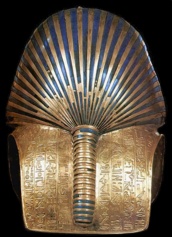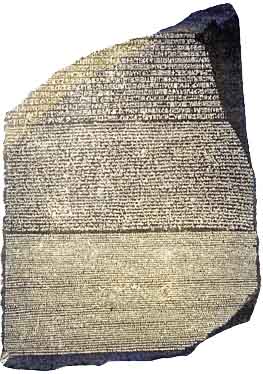


Making generalizations about the visual culture of any group of people is a crude endeavor, especially with a culture as diverse as Egypt's. With this thought in mind, know that this survey, as any must be, is tremendously limited in its breadth and depth.
[Look for a more in depth article to appear here soon.]
Examples of Egyptian art:
Egypt, The Seated Scribe, c. 2620-2350 BCE (Old Kingdom, 4th or 5th Dynasty), painted limestone statue, eyes inlaid with rock crystal and alabaster, circled with copper, 53.7 x 44 x 35 cm, Louvre. See hieroglyphics, polychrome, and portrait.

Egypt, El Giza, Great
Pyramid also known as "Pyramid of Cheops" or
"Khufu's Pyramid" (tallest of the three pictured),
2600-2480 BCE,
bearing masonry
(cut stone), 756 feet
square in plan,
height 481 feet (153 meters).
The square of its height equals the area of each
triangular face,
as determined by Herodotus in 450 BCE.
The base of the pyramid
covers about 13 acres. The pyramids at Giza are descendants of
earlier stepped designs which were built in superimposed layers.
They are gigantic prisms
unique in world architecture.
To build the Great Pyramid it took an about 2,300,000 dressed
stone blocks (averaging 2.5 tons each) — more than any other structure ever built.
Contemporary Egyptologists think the blocks were moved on log
rollers and sledges, and then ramped into place. Also visit The
Giza Plateau Mapping Project of the U. of Chicago Oriental
Art Institute and Explore the Pyramids by NOVA Online. The
Great Pyramid is one of the Seven
Wonders of the Ancient World.

Egypt, Gizeh, 2599-2571 BCE
(4th Dynasty), King
Menkaure and Queen Kha-merer-nebty II, stone.
Egyptian, c. 2575-2323 BCE, 4th-5th Dynasties, Headrest with Fluted Pedestal, calcite (Egyptian alabaster), 9 x 7 7/8 x 3 3/4 inches (22.9 x 19.9 x 9.3 cm), Michael C. Carlos Museum, Atlanta, GA. See fluted.
The Great Sphinx at Gizeh, 2500 BCE, 4th Dynasty. See sphinx.

Egypt, Statue of Amenemhat III (reigned 1850-1800
BCE),
19th century BC, diorite-gneiss,
height 86.5 cm, Hermitage
Museum, St. Petersburg, Russia.

Egypt, c. 1400-1300 BCE,
18th Dynasty, Chair, wood, inlaid
with ivory (or
bone); the leather strips are
modern, 91 x 47.5 x 59
cm, Louvre. See furniture.

Egypt, 1391-1353 BCE,
Dynasty 18, Sphinx of Amenhotep III, faience,
length 9 7/8 inches (25
cm), Metropolitan Museum of Art, NY. See sphinx.

Egyptian, Throne Back Depicting Tutankhamen and Queen,
New Kingdom, 18th Dyn., c. 1360 BCE,
Cairo Museum, Egypt.


Egyptian, Mask of King Tutankhamen, front and back,
gold and inlaid stones,
weight 11 kg, Cairo Museum,
Egypt. The
Egyptian pharoah named Tutankhamen
reigned from 1347 to 1337 BCE
(New Kingdom, 18th Dynasty). His tomb was opened in 1922. See
mask.

Egypt, Stele of the Royal Scribe Ipi, mid-14th
century BCE,
limestone, mineral paint,
95 x 71 cm, Hermitage Museum, St. Petersburg, Russia. In the
scene at the center of the stele, Ipi, a royal scribe, worships
the god Anubis. Anubis, shown with a canine head, was god of
the deceased.

Egypt, 203 BCE,
Rosetta
Stone, a slab of granite,
3 feet 9 inches x 2 feet 4 inches wide x 11 inches thick (118
x 77cm), the remains of a stele
inscribed in three scripts:
hieroglyphic, later Egyptian demotic -- a cursive form of ancient
Egyptian, and ancient Greek. Each of these three scripts were
being used in Egypt at the time it was carved. An officer of
Napoleon's engineering corps found the stone half buried in the
mud near Rosetta, a city near Alexandria, in 1799. Carved
on the stone is a decree
by Egyptian priests to commemorate
the crowning of Ptolemy V Epiphanes, king of Egypt from 203 -
181 BCE
The Stone is an icon of
script and decipherment.
Egypt (probably late Ptolemaic Period, c. 167 - 30 BCE), Wrapped Mummy with Cartonnage Trappings, human remains, linen, cartonnage, paint, gilt, 67 x 17 1/4 x 10 inches (170 x 43.5 x 25.4 cm), Michael C. Carlos Museum, Emory U, Atlanta, GA.

Egypt, Early Roman period, c. 15 BCE,
Temple of Dendur, Aeolian sandstone,
length of gateway and temple
82 feet (25 m), Metropolitan Museum of Art, NY. See architecture.

Egypt, second century CE,
Hawara, Roman Period, Funerary Portrait of a Young Girl, encaustic on wood,
height 15 3/4 inches, Cleveland
Museum of Art. See Fayum portraits
and portrait.
Also see archaeology, azurite, Coptic art, ethnic, Meroitic art, orientalism, sarcophagus, Seven Wonders of the Ancient World, and ushabti.
https://inform.quest/_art
Copyright © 1996-![]()